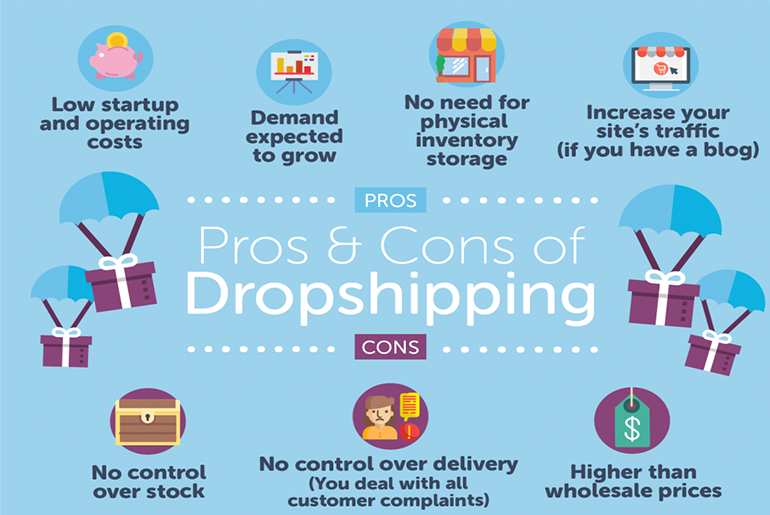Pros, Cons, and Right Approaches
If you are considering Dropshipping, you’re certainly not alone. In 2020, searches for “Dropshipping” hit an all-time high, according to Google Trends.
The concept is pretty simple: you list products for sale on your site. The products are manufactured and held by a third party. When the order is placed, the third party ships products directly to the consumer.
The power to add inventory without having to deal with production, stocking, or fulfilling orders may appear like a dream, the success of well-known brands that were built on Dropshipping, like Wayfair, make it all the more exciting.
But Then Again is Dropshipping in 2021 worth it? Let’s delve into some of the advantages and disadvantages to help you make safe and better decisions for your business.
The Pros of Dropshipping
Low Entry Barrier
Uniformly, traditional and online stores often necessitate a substantial financial investment to develop, manufacture, and source products. Extra costs linked with stocking inventory, preserving a physical presence, staffing locations, and marketing to new customers can really add up and ultimately exceeds the cost.
Dropshipping on the contrary offers much lower barriers to entry because one does not have to worry about purchasing and storing inventory or developing new products.
Generate Passive Income
Passive income is made with little to no daily effort, although it does require upfront work and constant monitoring. With Dropshipping, it is possible to be working on other aspects of your business whilst orders are placed and fulfilled automatically.
No Inventory Management
Traditionally, retailers pay up-front production costs and wait for delivery than stock products in a warehouse or a shop. If a certain product is not available for customers at the time of purchase, sales are lost.
Inventory management involves storage and handling costs, someone has to fold shirts and put them on the shelves, and you could purchase or manufacture large numbers of inventory that don’t sell, so there’s substantial financial risk involved.
No Need for a Physical Storefront
Dropshipping forbids the need for a physical shopfront, which implies no lease or mortgage and no construction costs, no upkeep.
Better Cash Flow
Normally, retailers purchase products, await their arrival and then sell them to the customers. For a period, they’ve spent a noteworthy amount of money without the ability to make it backward.
Through Dropshipping, you receive payment for the products at the same time you pay your providers or before. This frees up cash for marketing and growth.
Testing new products with minimum risk
Innovation is crucial to keep customers engaged; however fear of investing money into new products with unconfirmed track records thwarts many business owners from moving forward.
Dropshipping allows you to test new product lines devoid of spending lots of money. If customers do not respond to a new item, you can simply remove it from your store.
The Cons of Dropshipping
High-level competition
The same low entry barrier that makes Dropshipping attractive builds heavy competition. Other stores are not selling similar products; they are selling identical products from the same third-party manufacturers. You will have to find ways to stand out to compete.
Disorganized orders
If you have a range of products listed in your store, they might come from different suppliers. Customers may get multiple packages for the same order, which can lead to high shipping costs, inefficient packaging, confusing branding, and an annoyed customer base.
Race to the floor
Distinguishing your store can be tough. Many stores try to compete on price but, with so much competition they find themselves setting lower and lower prices. If you are careful enough, you will sell lots of inventory, but at prices so low that you end up losing money.
Scarcity of control
When Dropshipping, inventory seldom passes through your hands, you do not have the chance to certify that products are in top condition. Without quality control, you are putting your store’s repute in the hands of a third party. One bad batch of products could lead to unhappy customers and substantial loss of sales. Unless you have a special deal with your suppliers, you can’t use packaging to make your store unique, involving coupons to drive additional purchases, adding thank you note that urge customer loyalty, or customize boxes and envelopes.
Volume discounts
One of the reasons big-box retailers can sell products at low prices is due to economies of scale. They get major discounts on products because they purchase such a huge volume, and they give those discounts to shoppers.
With Dropshipping, you can say farewell to bulk and volume discounts, as you’re essentially purchasing products one at a time. Until you generate enough sales to give you some negotiation leverage, you are paying what the suppliers ask.
The Right Approaches to Dropshipping
Dropshipping makes a better sideshow than the main event. While its faults make it hard to support a business on its own, it still offers enough advantages to aid e-commerce companies to improve their business significantly.
Below are four approaches to use Dropshipping effectively.
Market research
Dropshipping works better as means to an end, not the end itself. While a long-term pledge to Dropshipping is impractical, using it for temporary projects can be extremely useful particularly in market research. Using Dropshipping to alleviate the risk in trying out new products and used for market research. Instead of raising your inventory costs by loading your warehouse with an unpredictable product, test it out by a trial period using Dropshipping.
More than just discovering if it sells or not, you will have a better estimate of how much it sells for. Giving you a more precise number of what quantities to buy for your initial stock. This is especially important for trying out new product types, which at all times carry an inherent risk. For instance, you have been quite successful at selling dog products. Would that turn well for cat products too?
Protection from overselling.
Knowledgeable Ecommerce brands know that market instabilities are not always predictable. Instead of raising inventory costs by overstocking to meet unlikely maximums, having a Dropshipping supplier as a backup saves you money without losing those sales.
This is especially useful for seasonal overspill. You can cut costs by stocking up on only the inventory you know will sell, and if an unforeseen demand for sales comes in, you can fulfill them with Dropshipping. It is a great precaution in contrast to the uncertainties all retailers may face. Having Dropshipping possibilities in place also makes great insurance against extreme situations.
Strategic shipping systems.
One ill-fated consequence of expanding your business is shipping complications. The farther out you get from your warehouse or fulfillment centers, the more shipping fees you will incur.
Dropshipping can be a good solution for some problematic locations that fall outside your profitable regions.
- Shipping that costs too much or maybe storage prices are too high to justify setting up a new shipping center.
- Maybe it is an issue of taxes or extra fees when shipping out of the country or state. Relying on dropshipping for these select areas could be the deciding factor in keeping you out of the red.
High Maintenance Products
Certain products cost more to stock and ship than others.
In particular circumstances, it may be more profitable for you to dropship them vs storing them yourself.
Any products that necessitate extra fees for storing or shipping, such as:
- Large products: Some products take up so much space, their sales do not make up the costs of the extra storage room.
- Heavy products: If the product’s weight makes it cost too much to ship, aim towards Dropshipping from a manufacturer or wholesaler.
- Fragile products: Fragile products require special care when shipping. In such cases, the supplier or manufacturer may be better equipped to meet these requirements compared to you.
- Valuables: High-value items like fine jewelry, antiques, etc., require extra security that not all warehouses can offer. Instead of risking theft, leave storage to someone who can effectively protect them.
- Special conditions: Maybe you ought to sell items that need to be kept frozen. If your inventory demands special conditions, you may be better off Dropshipping rather than storing it yourself.






